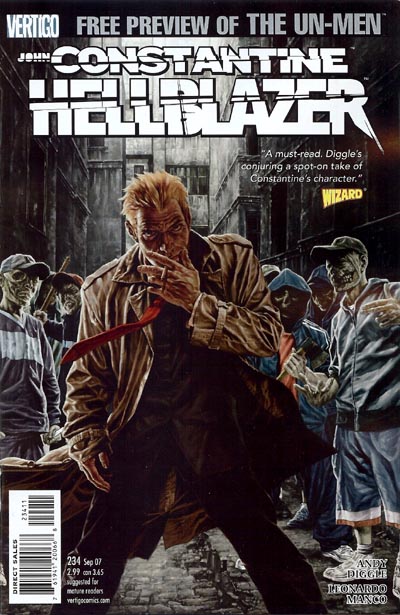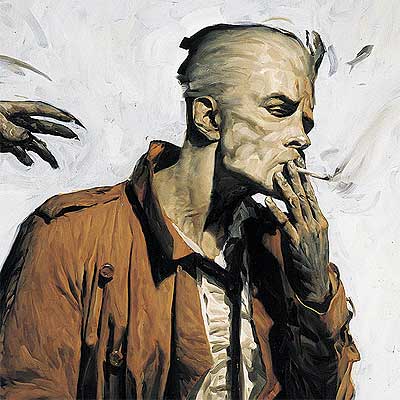Led Zeppelin: Houses of the Holy
 O.k. I know the two-tone burning Zeppelin image is the Zep equivalent of the Stones’ tongue logo but when I think of Bonzo and co. album covers – I think of Richard Drews’ novelty rotating disc sleeve for Led Zeppelin III,
O.k. I know the two-tone burning Zeppelin image is the Zep equivalent of the Stones’ tongue logo but when I think of Bonzo and co. album covers – I think of Richard Drews’ novelty rotating disc sleeve for Led Zeppelin III,
 Peter Corristons‘ Physical Grafitti,
Peter Corristons‘ Physical Grafitti,

 and 1973’s Houses of the Holy, designed by Aubrey Powell and Storm Thorgerson.
To be honest I’m not a huge fan personally of the art for Zeppelin 1 and 2. The fourth album was branded with the cool zep-occult symbols and gave us the straw carrier and the torch bearer but I find them a little too closely related to the billions of shithouse druid-loving fantasy art metal album covers that came after them. CODA has to be one of the worst album covers of all time (and not in a Millie Jackson way). Presence had some great photography accompanying the record (also by Storm Thorgerson) and may well be the classiest zep cover but for me, Houses of the Holy is direct, efficient (in a long-winded, fantasy-art way) and a great representation of a band turning from ye olde metal/folk blues into something more universal .
Like the band themselves (and I love Zeppelin) the ‘Houses of the Holy’ cover art is all grand ingredients; pompous, epic nonsense – juvenile fantasy – innocence/sexuality (see Blind Faithpost for a more direct example of nudie kids in rock art history) conceptual mysticism, dynamic contrasts, big effects (for the time) and, ultimately, more depth than a concept that is potentially lacking ’seriousness’ (again, like the band) might have achieved.
Thorgerson, Powell and (later) Peter Christopherson were the core of London-based Hipgnosis(not the polish electronica outfit), something of a popular choice for 70’s rockers, having also done Sabbath, Pink Floyd, Yes, Styx and other contemporary album covers.
Wikipedia claims Thorgerson was fired after getting on the wrong side of the band with an idea involving an electric green tennis court – but Aubrey Powell’s account implies the band simply opted for one of two ideas from the design team.
The design itself was inspired by an Arthur C. Clarke sci-fi story that contained a final act where loads of semi-formed human children run, like lemmings, off the edge of the earth (I always found the fact that no children are facing the camera a little ominous and this backstory makes them even creepier).
and 1973’s Houses of the Holy, designed by Aubrey Powell and Storm Thorgerson.
To be honest I’m not a huge fan personally of the art for Zeppelin 1 and 2. The fourth album was branded with the cool zep-occult symbols and gave us the straw carrier and the torch bearer but I find them a little too closely related to the billions of shithouse druid-loving fantasy art metal album covers that came after them. CODA has to be one of the worst album covers of all time (and not in a Millie Jackson way). Presence had some great photography accompanying the record (also by Storm Thorgerson) and may well be the classiest zep cover but for me, Houses of the Holy is direct, efficient (in a long-winded, fantasy-art way) and a great representation of a band turning from ye olde metal/folk blues into something more universal .
Like the band themselves (and I love Zeppelin) the ‘Houses of the Holy’ cover art is all grand ingredients; pompous, epic nonsense – juvenile fantasy – innocence/sexuality (see Blind Faithpost for a more direct example of nudie kids in rock art history) conceptual mysticism, dynamic contrasts, big effects (for the time) and, ultimately, more depth than a concept that is potentially lacking ’seriousness’ (again, like the band) might have achieved.
Thorgerson, Powell and (later) Peter Christopherson were the core of London-based Hipgnosis(not the polish electronica outfit), something of a popular choice for 70’s rockers, having also done Sabbath, Pink Floyd, Yes, Styx and other contemporary album covers.
Wikipedia claims Thorgerson was fired after getting on the wrong side of the band with an idea involving an electric green tennis court – but Aubrey Powell’s account implies the band simply opted for one of two ideas from the design team.
The design itself was inspired by an Arthur C. Clarke sci-fi story that contained a final act where loads of semi-formed human children run, like lemmings, off the edge of the earth (I always found the fact that no children are facing the camera a little ominous and this backstory makes them even creepier).
 Powell explains the shooting conditions at Giant’s Causeway in Northern Ireland atsuperseventies.com
- “I shot the whole thing in black and white on a totally miserable morning pouring with rain.” Though the cover appears to be one wide-frame photograph, it is actually a collage of thirty different shots; only two children posed for the shoot. “Originally,” says Powell, “I’d intended the children to be gold and silver. Because I shot in black and white and it was a gray day, the children turned out very white. So when we hand-tinted it, the airbrush artist, by accident, put a kind of purple tinge onto them. When I first saw it, I said, ‘Oh, my God.’ Then we looked at it, and I said, ‘Hang on a minute — this has an otherworldly quality.’ So we left it as it was.”
Powell explains the shooting conditions at Giant’s Causeway in Northern Ireland atsuperseventies.com
- “I shot the whole thing in black and white on a totally miserable morning pouring with rain.” Though the cover appears to be one wide-frame photograph, it is actually a collage of thirty different shots; only two children posed for the shoot. “Originally,” says Powell, “I’d intended the children to be gold and silver. Because I shot in black and white and it was a gray day, the children turned out very white. So when we hand-tinted it, the airbrush artist, by accident, put a kind of purple tinge onto them. When I first saw it, I said, ‘Oh, my God.’ Then we looked at it, and I said, ‘Hang on a minute — this has an otherworldly quality.’ So we left it as it was.”
 It’s definitely a side effect of living in an age that plunders the past for modern ideas but the fact these images could still sit comfortably (apologies to anyone noting the cart before the horse) underneath a Wolfmother or Priestess logo gives creedence to clarity of the concepts and the contribution Powell/Thorgerson made to setting a standard for contemporary 20th century album art design.
Originally, the album was released with a thin paper cuff, featuring the bands name and album title, which covered the little phosphorous asses of the kids.
Unfortunately, just like 2 years earlier, the Spanish government went a bit pink in the cheeks and banned the album (apparently some southern states in the U.S. did the same) and the familiar image is now the one with Atlantics’ contribution to ‘functional’ design.
The almost hand-drawn, thin-lined, b&w font actually looks great with the photo, complementing the big chunks of colour and soft edges of images – but it’s in the wrong spot innit?
It’s definitely a side effect of living in an age that plunders the past for modern ideas but the fact these images could still sit comfortably (apologies to anyone noting the cart before the horse) underneath a Wolfmother or Priestess logo gives creedence to clarity of the concepts and the contribution Powell/Thorgerson made to setting a standard for contemporary 20th century album art design.
Originally, the album was released with a thin paper cuff, featuring the bands name and album title, which covered the little phosphorous asses of the kids.
Unfortunately, just like 2 years earlier, the Spanish government went a bit pink in the cheeks and banned the album (apparently some southern states in the U.S. did the same) and the familiar image is now the one with Atlantics’ contribution to ‘functional’ design.
The almost hand-drawn, thin-lined, b&w font actually looks great with the photo, complementing the big chunks of colour and soft edges of images – but it’s in the wrong spot innit?
 Zeppelin excelled the way a talented athlete does – by moving, running, jumping, sweating – and attacks on their contributions to ’serious’ art/music are like chiding a football team for not knowing how to long divide without a calculator.
So to me, even tho’ some of Led Zeppelins’ artwork may seem a little hokey, including this one – Houses of the Holy remains the perfect banner for it’s team at the time. Confident, epic, menacing, naive and (sorry about the poor pun) cheeky…
Zeppelin excelled the way a talented athlete does – by moving, running, jumping, sweating – and attacks on their contributions to ’serious’ art/music are like chiding a football team for not knowing how to long divide without a calculator.
So to me, even tho’ some of Led Zeppelins’ artwork may seem a little hokey, including this one – Houses of the Holy remains the perfect banner for it’s team at the time. Confident, epic, menacing, naive and (sorry about the poor pun) cheeky…Posted by dan on 8 January, 2008
Album: Houses of the HolyArtist: Led Zeppelin
Cover Artist: Aubrey Powell, Storm Thorgerson
Record Label: Atlantic
Design Studio: Hipgnosis
Year: 1973











No comments:
Post a Comment